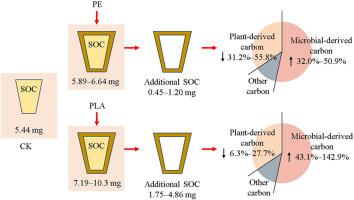当前位置:
X-MOL 学术
›
Environ. Pollut.
›
论文详情
Our official English website, www.x-mol.net, welcomes your feedback! (Note: you will need to create a separate account there.)
Differential carbon accumulation of microbial necromass and plant lignin by pollution of polyethylene and polylactic acid microplastics in soil
Environmental Pollution ( IF 7.6 ) Pub Date : 2024-07-03 , DOI: 10.1016/j.envpol.2024.124504 Hong Yu , Haixia Liu , Ke Yang , Beidou Xi , Wenbing Tan
Environmental Pollution ( IF 7.6 ) Pub Date : 2024-07-03 , DOI: 10.1016/j.envpol.2024.124504 Hong Yu , Haixia Liu , Ke Yang , Beidou Xi , Wenbing Tan

|
The wide microplastics (MPs) occurrence affects soil physicochemical and biological properties, thereby influencing its carbon cycling and storage. However, the regulation effect of MPs on soil organic carbon (SOC) formation and stabilization remains unclear, hindering the accurate prediction of carbon sequestration in future global changes under continuous MP pollution. Phospholipid fatty acids, amino sugars and lignin phenols were used in this study as biomarkers for microbial community composition, microbial necromass and plant lignin components, respectively, and their responses to conventional (polyethylene; PE) and biodegradable (polylactic acid; PLA) MPs were explored. Results showed PLA MPs had positive effects on soil microbial biomass, while the positive and negative effects of PE MPs on microbial biomass varied with MP concentration. PE and PLA MPs increased microbial necromass contents and their contribution to SOC, mainly due to the increase in fungal necromass. On the contrary, PE and PLA MPs reduced lignin phenols and their contribution to SOC, mainly owing to the reduction in vanillyl-type phenols. The response of microbial necromass to PLA MPs was higher than that to PE MPs, whereas the response of lignin phenols was the opposite. MPs increased SOC level, with 83%–200% and 50%–75% of additional SOC in PE and PLA treatments, respectively, originating from microbial necromass carbon. This finding indicates that the increase in SOC pool in the presence of MPs can be attributed to soil microbial necromass carbon, and MPs increased capacity and efficacy of microbial carbon pump by increasing microbial turnover and reducing microbial N limitation. Moreover, the increase in amino sugars to lignin phenols ratio in PE treatment was higher than that in PLA treatment, and the increase in SOC content in PLA treatment was higher than that in PE treatment, indicating a high possibility of SOC storage owing to PLA MPs.
中文翻译:

土壤中聚乙烯和聚乳酸微塑料污染引起的微生物坏死物和植物木质素碳积累差异
微塑料(MPs)的广泛存在影响土壤的理化和生物特性,从而影响其碳循环和储存。然而,MPs对土壤有机碳(SOC)形成和稳定的调节作用尚不清楚,阻碍了MPs持续污染下未来全球变化中碳汇的准确预测。本研究分别使用磷脂脂肪酸、氨基糖和木质素酚作为微生物群落组成、微生物坏死物和植物木质素成分的生物标志物,并研究了它们对传统(聚乙烯;PE)和可生物降解(聚乳酸;PLA)MP 的响应。探索过。结果表明,PLA MPs 对土壤微生物量有积极作用,而 PE MPs 对微生物量的正负作用随 MP 浓度的不同而变化。 PE 和 PLA MP 增加了微生物坏死物含量及其对 SOC 的贡献,这主要是由于真菌坏死物的增加。相反,PE 和 PLA MP 减少了木质素酚及其对 SOC 的贡献,这主要是由于香草基型酚的减少。微生物坏死物对PLA MPs的响应高于对PE MPs的响应,而木质素酚的响应则相反。 MPs 增加了 SOC 水平,PE 和 PLA 处理中分别增加了 83%–200% 和 50%–75% 的 SOC,源自微生物坏死物碳。这一发现表明,MP 存在下 SOC 库的增加可归因于土壤微生物坏死体碳,MP 通过增加微生物周转和减少微生物氮限制来提高微生物碳泵的容量和效率。 此外,PE处理中氨基糖与木质素酚比值的增加幅度高于PLA处理,并且PLA处理中SOC含量的增加幅度高于PE处理,表明PLA MPs储存SOC的可能性较高。
更新日期:2024-07-03
中文翻译:

土壤中聚乙烯和聚乳酸微塑料污染引起的微生物坏死物和植物木质素碳积累差异
微塑料(MPs)的广泛存在影响土壤的理化和生物特性,从而影响其碳循环和储存。然而,MPs对土壤有机碳(SOC)形成和稳定的调节作用尚不清楚,阻碍了MPs持续污染下未来全球变化中碳汇的准确预测。本研究分别使用磷脂脂肪酸、氨基糖和木质素酚作为微生物群落组成、微生物坏死物和植物木质素成分的生物标志物,并研究了它们对传统(聚乙烯;PE)和可生物降解(聚乳酸;PLA)MP 的响应。探索过。结果表明,PLA MPs 对土壤微生物量有积极作用,而 PE MPs 对微生物量的正负作用随 MP 浓度的不同而变化。 PE 和 PLA MP 增加了微生物坏死物含量及其对 SOC 的贡献,这主要是由于真菌坏死物的增加。相反,PE 和 PLA MP 减少了木质素酚及其对 SOC 的贡献,这主要是由于香草基型酚的减少。微生物坏死物对PLA MPs的响应高于对PE MPs的响应,而木质素酚的响应则相反。 MPs 增加了 SOC 水平,PE 和 PLA 处理中分别增加了 83%–200% 和 50%–75% 的 SOC,源自微生物坏死物碳。这一发现表明,MP 存在下 SOC 库的增加可归因于土壤微生物坏死体碳,MP 通过增加微生物周转和减少微生物氮限制来提高微生物碳泵的容量和效率。 此外,PE处理中氨基糖与木质素酚比值的增加幅度高于PLA处理,并且PLA处理中SOC含量的增加幅度高于PE处理,表明PLA MPs储存SOC的可能性较高。











































 京公网安备 11010802027423号
京公网安备 11010802027423号